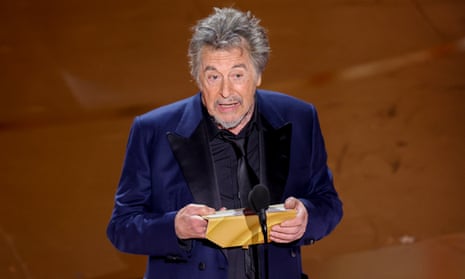Al Pacino says he was following the instructions of the Oscars producers when he did not name any of the other best picture nominees while announcing Oppenheimer as the winner of the show’s biggest category.
The Oscar-winning actor was Sunday night’s final presenter and announced Oppenheimer as the best picture winner without naming the full slate of nominees, as is tradition.
“I just want to be clear it was not my intention to omit them, rather a choice by the producers not to have them said again since they were highlighted individually throughout the ceremony,” Pacino said in a statement Monday afternoon. “I was honoured to be a part of the evening and chose to follow the way they wished for this award to be presented.
“I realise being nominated is a huge milestone in one’s life and to not be fully recognised is offensive and hurtful. I say this as someone who profoundly relates with film-makers, actors and producers so I deeply empathise with those who have been slighted by this oversight and it’s why I felt it necessary to make this statement.”
Pacino is a nine-time acting nominee, and won the Oscar for best actor for 1992’s Scent of a Woman.
The 10 nominated films – American Fiction, Anatomy of a Fall, Barbie, The Holdovers, Killers of the Flower Moon, Maestro, Oppenheimer, Past Lives, Poor Things and The Zone of Interest – all had individual montages shown during the ceremony.
But Pacino’s abrupt delivery of the winner – saying “Best picture … uh, I have to go to the envelope for that. And I will. Here it comes. And my eyes see Oppenheimer?” – left many in the room and viewers at home confused.
Best picture was not the only category to omit a reading of the nominees. The nominated original songs were all performed during the show, and the announcement that What Was I Made For? from Barbie had won was made without listing them all again.
Oscars producer Molly McNearney told the trade publication Variety that skipping the reading of the best picture nominees was intentional.
“It was a creative decision we made because we were very worried that the show was going to be long,” she said. “By the time you get to the end of the show, you’ve seen all 10 best picture clip packages. People just want to hear who wins and they’re pretty ready for the show to be over. At least that’s what we anticipated.
“I apologise if our decision to not have to read through all those nominations put [Pacino] in a tough spot.”
McNearney said Pacino’s decision not to use the traditional phrase – “And the Oscar goes to …” – did make things “a little confusing”, although she added: “But listen, that’s the excitement of live television. You never know you’re going to get exactly!”
After the ceremony ended, host Jimmy Kimmel said of Pacino’s presentation style: “I guess he’s never watched an awards show before. It seems like everyone in America knows the rhythm of how it’s supposed to go … down to the ‘And the Oscar goes to …’ But not Al Pacino! God bless him.”
After the Oscars ceremony finished, Pacino announced his memoir, Sonny Boy, will be published in October. The highly anticipated book, years in the making, will cover the 83-year-old actor’s childhood in New York, his upbringing with his “fiercely loving but mentally unwell mother and her parents”, his troop of young friends in the South Bronx and his time at New York’s fabled High School of Performing Arts.
It will then cover his work in New York’s avant garde theatre scene in the 1960s and 70s before his major movie break with The Panic in Needle Park, The Godfather and The Godfather Part II, Serpico and Dog Day Afternoon.
